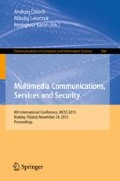Abstract
The paper presents a new approach to modeling and analysis of conflicting spatial phenomena. The proposal is based on an extension of Cellular Automata. A new approach, namely Layered Competitive Cellular Automata for modeling of spatial conflicts of dynamic nature is put forward. The idea of this approach consists in building two or more levels of the grid with competitive automata and defining influences about them. A first implementation is presented and application example illustrating the approach is provided.
A. Ligęza—AGH Research Contract No.: 11.11.120.859.
Access this chapter
Tax calculation will be finalised at checkout
Purchases are for personal use only
Notes
- 1.
Chinese military general, strategist, and philosopher who lived in the Spring and Autumn period of ancient China. According to him: War is the greatest thing of the state, the basis of life and death, Tao survival or destruction. It must be carefully considered and analyzed.
(Sun Tzu: The Art of War).
References
Bowen, K.C., McNaught, K.R.: Mathematics in warfare: lanchester theory. In: Fletcher, J. (ed.) The Lanchester Legacy. A Celebration of Genius, vol. 3. Coventry University Press, Coventry (1996)
Cecherrini-Silberstein, T., Curnaert, M.: Cellular Automata and Groups. Springer, Heidelberg (2010)
Davis, P.K.: Distributed interactive simulation in the evolution of DoD warfare modeling and simulation. Proc. IEEE 83(8), 1138–1155 (1995)
Deja, R.: Conflict analysis. In: Proceedings of the Fourth International Workshop on Rough Sets, Fuzzy Sets and Machine Discovery, The University of Tokyo, vol. 6–8, pp. 118–124, November 1996
Deja, R.: Conflict model with negotiation. Bull. Pol. Acad. Sci. Techn. Sci. 44(4), 475–498 (1996)
Epstein, J.M.: The Calculus of Conventional War: Dynamic Analysis without Lanchester Theory. Brookings Institution, Washington (1985)
Garg, R.: An Introduction to Game Theory. Oxford University Press, Chicago (2004)
Lanchester, F.W.: Aircraft in Warfare: The Dawn of the Fourth Arm. Constable and Co Ltd., London (1916)
Mitchell, M.: Nonstandard Computation. Verlagsgesellschaft, Weinheim (1998)
Moffat, J.: Mathematical modelling of information age conflict. J. Appl. Math. Decis. Sci. 2006, 15 (2006)
Pawlak, Z.: On Conflicts. Int. J. of Man-Mach. Stud. 21, 127–134 (1984)
Pawlak, Z.: O Konfliktach. Państwowe Wydawnictwo Naukowe, Warszawa (1987)
Pawlak, Z.: Anatomy of Conflicts. Bull. EATCS 50, 234–246 (1993)
Pawlak, Z.: An inquiry into anatomy of conflicts. J. Inf. Sci. 109, 65–78 (1998)
Ratajczak, S.: Porównanie wybranych definicji symulacji. In: Symulacja Systemów Gospodarczych, Prace Szkoły Antaływka 1997, WSPiZ IOiZ PWr, Warszawa (1997)
Schiff, J.L.: Cellular Automata: A Discrete View of the World. Wiley, Hoboken (2008)
Summerfield, M.: Rapid GUI Programming with Python and QT. Prentice Hall, Upper Saddle River (2007)
http://riad.usk.pk.edu.pl/rhk/odrodzenie/odrodzenie/odrodz6.html
Maiti, N.S., Ghosh, S., Chaudhuri, P.P.: Cellular Automata (CA) model for primality test. In: Wąs, J., Sirakoulis, G.C., Bandini, S. (eds.) ACRI 2014. LNCS, vol. 8751, pp. 146–155. Springer, Heidelberg (2014)
Wolfram, S.: Statistical mechanics of cellular automata. Rev. Mod. Phys. 55(3), 601 (1983)
Zelle, J.: Python Programming: An Introduction to Computer Science. Franklin, Beedle & Associates Inc., Wilsonville (2004)
Author information
Authors and Affiliations
Corresponding author
Editor information
Editors and Affiliations
Rights and permissions
Copyright information
© 2015 Springer International Publishing Switzerland
About this paper
Cite this paper
Stachura-Terlecka, B., Ligęza, A. (2015). Modeling and Analysis of Spatial Conflicts with Layered Competitive Cellular Automata. In: Dziech, A., Leszczuk, M., Baran, R. (eds) Multimedia Communications, Services and Security. MCSS 2015. Communications in Computer and Information Science, vol 566. Springer, Cham. https://doi.org/10.1007/978-3-319-26404-2_8
Download citation
DOI: https://doi.org/10.1007/978-3-319-26404-2_8
Published:
Publisher Name: Springer, Cham
Print ISBN: 978-3-319-26403-5
Online ISBN: 978-3-319-26404-2
eBook Packages: Computer ScienceComputer Science (R0)

